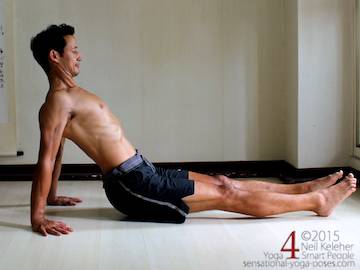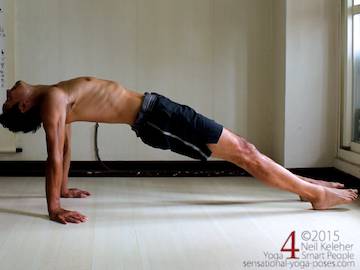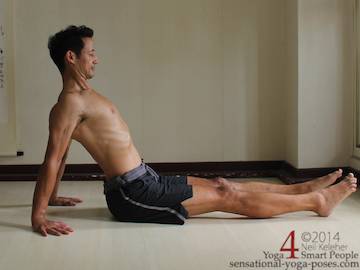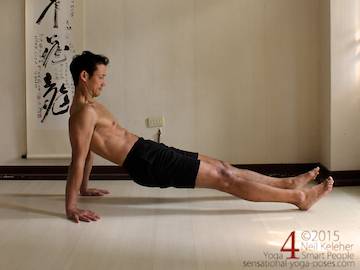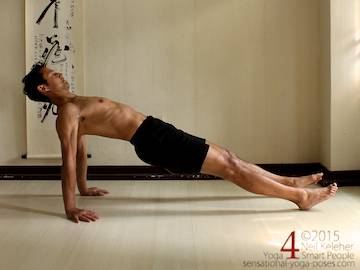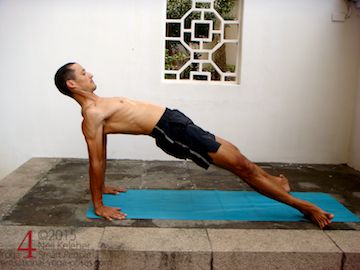Reverse Plank Yoga Pose
and Making it Less Unlikeable
The reverse plank yoga pose can often be quite uncomfortable for the backs of the legs. I'd suggest that one reason for this is that the hamstrings, and glutes, aren't being sufficiently utilized.
When doing this arm supported back-bending and back strengthening yoga pose, there is generally no instruction given to stabilize the knees or to deliberately activate the hamstrings and/or the glutes.
Of course, it helps if you know how to activate the hamstrings and glutes.
When teaching reverse plank, I'll have students engage quads first, then engage hamstrings and buttocks. Then the idea is to keep the hams and glutes engaged while lifting up.
Use a Slight Lift To Begin With
Rather than lifting up as high as possible straight off the bat, I'll have students lift slightly and get used to keeping the hams and glutes active. As long as the arms and feet are bearing the weight of your body and your butt and legs are clear of the floor then you are doing reverse plank.
Note that the general technique with reverse plank seems to be to lift up as high as possible as soon as possible. Basically you shove yourself up to maximum height and hang out there for however many breaths are required. Personally, I like to practice partial lifts with a focus on keeping the hamstrings active. From there one option is to repeatedly lift up into reverse plank, but going slowly and smoothly, and in addition, gradually going higher after each rep. The advantage in so doing is that the focus isn't on going as high as possible, but on feeling your body as you lift your body higher.
Is touching the forefeet to the floor a requirement of reverse plank pose?
As you can see I can't touch the fronts of my feet into the floor for this pose.
I'm not too worried about it though. I don't think that touching the front of the feet to the floor changes the pose that much, not unless the fronts of the feet press down into the floor with enough pressure to actually lift the heels (or at least cause the heels to be lighter on the floor.) But if you are interested in touching your feet to the floor I'd suggest the smartest route would be to focus on lifting the hips higher.
What I do like to play with is flexing the feet and pointing them. With the feet pointed then not only are the glutes and hams activated but the calves as well so that most of the back line of the legs is active.
Another set of actions that I do is to bend the spine backwards and activate the shoulders prior to lifting.
With hips still on the floor I first to use the shoulders to push the chest forwards. Then I bend the lumbar and thoracic spine backwards and at the same time open and expand the front of the ribcage.
This then lengthens the distance at the back of the hips making it easier to contract the buttocks. Then I activate buttocks and hamstrings and then I lift.
An exercise for improving shoulder awareness while in reverse plank is to relax the shoulders so that the ribcage sinks down (you can also bend the spine forwards) and then reactivate the shoulders to lift the ribcage up.
As mentioned I might start students of with lifting only a short distance. Then on succesive lifts the hips can be pushed gradually higher. Moving slowly up into the pose it can be easier to find the final position with less effort as opposed to just pushing up as fast and as high as possible.
Here I should note that another technique that can make this pose feel easier prior to lifting up is to push the hands forwards so that the shoulders pull back.
I think this action naturally cause the backs of the legs to activate, as if to resist the forwards push of the hands by pulling the feet rearwards.
Other variations of this pose include doing it with feet wider and or with feet turned outwards or inwards.
Indeed this was how I first used to do the pose to make it less uncomfortable while at the same time getting comfortable with internal and external hip rotation and exercising the outer and inner thighs. After these versions, then I'd do regular reverse plank with feet together, and knees pointing upwards.
Review
To make reverse plank easier, try engaging hamstrings and glutes prior to lifting.
Another action is to try and make the knee "strong" or "stable."
Or friction the hands forwards (towards the feet) so that the shoulders pull rearwards (away from the feet.)
You may be interested in...
If you have trouble with activating your hamstrings and glutes, the Basic Muscle Control Quads, Hip Flexors, Hamstrings and Gluteus Maximus video includes simple stand alone exercises for learning to feel and control these muscles.
For more ways that you can use friction when doing yoga poses, the Frictional Muscle Control video and PDF includes a sequence of yoga poses with a focus on using both friction and pressure to make yoga poses easier.
Published: 2015 07 27
Updated: 2020 10 22

